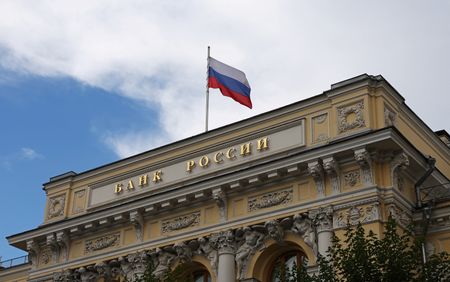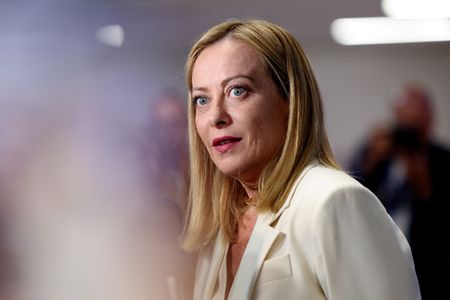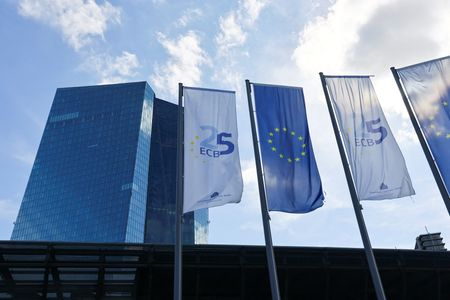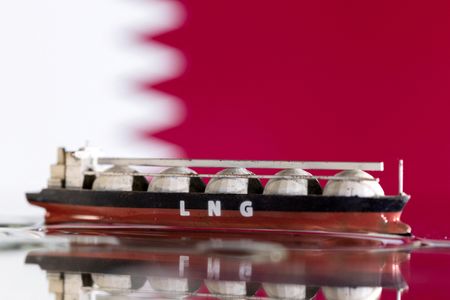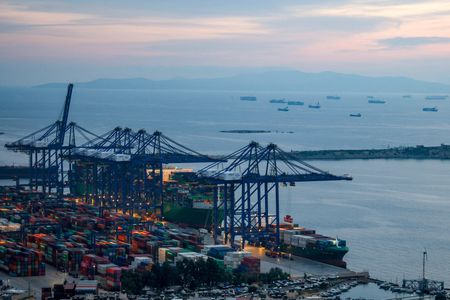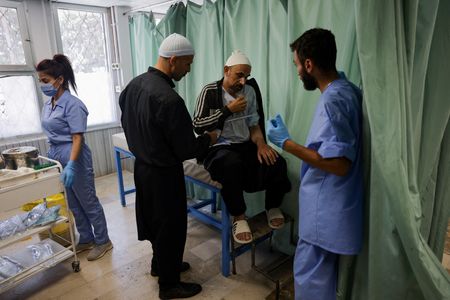By Elena Fabrichnaya and Gleb Bryanski
MOSCOW (Reuters) -The Russian central bank cut its key interest rate by 200 basis points to 18% on Friday, hoping to revive lending and boost flagging economic growth after stubbornly high inflation showed signs of easing.
The move is the biggest decrease since May 2022, when the central bank cut by 300 bps as the economy was recovering from the shock from Western sanctions imposed following the launch of Russia’s military action in Ukraine.
The latest reduction was in line with a Reuters poll of 27 economists, and comes after Russian business leaders and some government officials complained that high interest rates were strangling the economy.
The central bank had raised rates substantially since July 2023 in order to deal with the effects of an overheating economy caused by a surge in military spending. Russia’s economy minister said last month the country was on the brink of recession as a result.
Alongside its sharp rate cut, the central bank lowered its 2025 inflation forecast to between 6% and 7% from between 7% and 8% and said inflationary pressures were declining faster than previously forecast.
The bank said it would keep monetary conditions as tight as necessary to return inflation to the target of 4% in 2026.
“We are on the path to returning inflation to target, but this path has not yet been completed,” central bank governor Elvira Nabiullina said at a news conference following the rate decision.
“Returning to the target… implies a stable consolidation of inflation at a low level not only in actual data, but also in the perception of people and businesses,” she said.
Analysts now expect the central bank to continue cutting rates later this year.
“Everything points to a fairly significant optimism on the part of the central bank and allows us to expect a continuation of active monetary policy easing with the key rate not exceeding 16% by the end of the year,” Raiffrisen Bank analysts said.
WESTERN SANCTIONS
Russia’s consumer price index fell by 0.05% in the latest week, marking weekly deflation for the first time since September 2024, while annualized inflation slowed to 9.17% from its peak of 10.3% in March.
The central bank maintained its 2025 gross domestic product growth forecast at between 1% and 2% and said it saw some softening in Russia’s tight labour market. The economy grew by 4.3% last year.
The central bank cut its forecast for the average oil price in 2025 to $55 per barrel from $60 per barrel, implying a fall in state budget revenues, but Nabiullina said she did not expect any surprises from the budget.
The Russian economy will face another test in early September when a 50-day deadline set by U.S. President Donald Trump for Russia to show progress toward peace in Ukraine expires, with potential new U.S. sanctions against buyers of Russian oil to follow.
Nabiullina said the bank will work to ensure the financial sector’s resilience to Western sanctions does not weaken.
“We see that indeed the financial sector is one of the main targets for sanctions, and these sanctions are being tightened,” Nabiullina said.
The bank was under intense pressure from the business community to start easing after it hiked the key rate to the highest level since the early 2000s last year. Business leaders complained that at such a rate, investment no longer made sense.
Nabiullina said that such pressure does the economy a disservice by creating the false impression that the central bank has been forced to cave in when cutting rates, which in turn fuels inflationary expectations
“Such attempts to exert pressure would, in effect, result in higher interest rates,” she warned.
President Vladimir Putin has backed the policy of the central bank, but warned it not to cool the economy too much. High interest rates have hit Russia’s construction and coal sectors and led to a rise in bad debt for Russian banks.
Speaking just before the rate decision on Friday, Deputy Prime Minister Marat Khusnullin, who oversees the construction sector, said that a 400 bps cut was more desirable, indicating that many officials in Russia want the central bank to cut more.
The rouble, which rallied by 45% against the U.S. dollar earlier this year in part due to the high key rate, began to weaken ahead of the expected rate cut and touched the 80 mark against the dollar on Friday, a near-six week low.
The stronger rouble has aided the central bank in fighting inflation by making imported goods cheaper with some bankers alleging that supporting the rouble was a deliberate policy by the central bank.
(Additional reporting by Darya Korsunskaya, Anastasia Lyrchikova, Anton Kolodyazhny, Vladimir Soldatkin, Marina Bobrova; Editing by Mark Trevelyan and Toby Chopra)

